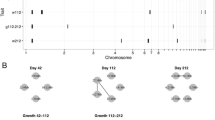Abstract
Marker-quantitative trait locus (QTL) linkage was evaluated in F2 intercross and backcross mouse populations derived from stocks differing dramatically in prolificacy and mature weight. A highly prolific outbred Quackenbush-Swiss mouse line, or an inbred line derived from it (16.62 ± 0.22 and 14.64 ± 0.27 pups per litter, respectively) were used as one of the grandparents in these populations. The less prolific C57BL/6J inbred mouse line (6.67 ± 0.37 pups per litter) was used as the other grandparent. Linkage was evaluated in a three-step process that involved selective genotyping of F2 intercross progeny representing extremes for prolificacy, genotyping of the full F2 for chromosomal regions potentially associated with prolificacy, and genotyping of the backcross for genomic regions significantly associated with prolificacy in the F2. Segments of Chromosomes (Chrs) 2 and 4 were significantly (P < 0.05, experiment-wise error rate) associated with prolificacy, and LOD scores suggestive of linkage were observed for litter size on Chr 9 and growth on Chrs 4 and 11. Existence of growth QTL was also supported by marker effects that were significant (P < 0.05) or approaching significance (P < 0.10) in the backcross. Additive litter size QTL effects ranged from 0.56 to 0.79 pups per litter, and dominance deviations ranged from −0.56 to 1.19 pups per litter, suggesting overdominance as a possible mode of gene action in some cases. The observation of pleiotropic or linked QTL for growth and prolificacy corresponds well with results from many selection experiments identifying positively correlated responses to selection for these two traits.
Similar content being viewed by others
References
Bradford GE (1971) Growth and reproduction in mice selected for rapid body weight gain. Genetics 69, 499–512
Bunger L, Renne U, Diett G (1992) Selection for body weight at 42 days in laboratory mice with and without litter size standardization—in direct response and correlated effects on litter size. Arch Anim Breed 35, 305–319
Cheverud JM, Routman EJ, Duarte FAM, van Swinderen B, Cothran K, Perel C (1996) Quantitative trait loci for murine growth. Genetics 142, 1305–1319
Collins AC, Martin ICA, Kirkpatrick BW (1993) Growth quantitative trait loci (QTL) on mouse Chromosome 10 in a Quackenbush-Swiss × C57BL/6J backcross. Mamm Genome 4, 454–458
Dietrich WF, Miller JC, Steen RG, Merchant M, Damron D, Nahf R, Gross A, Joyce DC, Wessel M, Dredge RD, Marquis A, Stein LD, Goodman N, Page DC, Lander ES (1994) A genetic map of the mouse with 4,006 simple sequence length polymorphisms. Nat Genet 7, 220–245
Durrant BS, Eisen EJ, Ulberg LC (1980) Ovulation rate, embryo survival and ovarian sensitivity to gonadotrophins in mice selected for litter size and body weight. J Reprod Fertil 59, 329–339
Falconer DS (1965) Maternal effects and selection response. Genetics Today. Proc. of XIth International Congress of Genetics (The Hague) pp 763–774
Joakimsen O, Baker RL (1977) Selection for litter size in mice. Acta Agric Scand 27, 301–317
Keightley PD, Torsten H, May L, Bulfield G (1996) A genetic map of quantitative trait loci for body weight in the mouse. Genetics 142, 227–235
Kirkpatrick BW, Rutledge JJ (1987) The influence of prenatal and postnatal fraternity size on reproduction in mice. Biol Reprod 36, 907–914
Kirkpatrick BW, Arias JA, Rutledge JJ (1988) Effects of prenatal and postnatal fraternity size on long-term reproduction in mice. J Anim Sci 66, 62–69
Lander ES, Botstein D (1989) Mapping Mendelian factors underlying quantitative traits using RFLP maps. Genetics 121, 185–199
Lander ES, Kruglyak L (1995) Genetic dissection of complex traits: guidelines for interpreting and reporting linkage results. Nat Genet 11, 241–247
Lander ES, Schork NJ (1994) Genetic dissection of complex traits. Science 265, 2037–2048
Mouse Genome Informatics (1996) Mouse Genome Database (MGD) 3.1. The Jackson Laboratory, Bar Harbor, Maine. World Wide Web (URL:http://www.informatics.jax.org/).
Pomp D, Eisen EJ, Ziecik AJ (1988) LH receptor induction and ovulation rate in mice selected for litter size and body weight. J Reprod Fertil 84, 601–609
Pomp D, Cushman MA, Foster SC, Drudik DK, Fortman M, Eisen EJ (1994) Identification of quantitative trait loci for body weight and body fat in mice. Proceedings of the 5th World Congress on Genetics Applied to Livestock Production 21, 209–212. University of Guelph, Guelph, Ontario, Canada.
Pomp D, Foster S, Cushman MA, Eisen G (1995) Identification of genes controlling quantitative reproduction traits in mice. Biol Reprod 52 (Suppl 1), 61
Rahnefeld GW, Boylan WJ, Comstock RE (1962) Genetic correlation between growth rate and litter size in mice. Can J Genet Cytol 40, 289–295
Rhanefeld GW, Comstock RE, Singh M, NaPuket SR (1966) Genetic correlation between growth rate and litter size in mice. Genetics 54, 1423–1429
Richards FJ (1959) A flexible growth function for empirical use. J Exp Bot 10, 290–300
SAS Institute Inc. (1989) SAS/STAT User’s Guide, Version 6, 4th ed., Vol. 2, pp 1135–1194. Cary, NC.
Silver LM (1995) Mouse Genetics, Concepts and Applications, (New York: Oxford University Press), p 62
Spearow JL, Keisner S, Carr L, Peters M, Barthelow J, Faridi J, Freed R, Bury R, Patel V, Barkley M (1995) Biol Reprod 52 (Suppl 1), 61
Author information
Authors and Affiliations
Rights and permissions
About this article
Cite this article
Kirkpatrick, B.W., Mengelt, A., Schulman, N. et al. Identification of quantitative trait loci for prolificacy and growth in mice. Mammalian Genome 9, 97–102 (1998). https://doi.org/10.1007/s003359900696
Received:
Accepted:
Issue Date:
DOI: https://doi.org/10.1007/s003359900696




